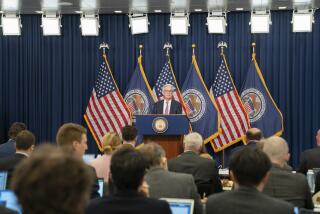Panel to Consider Deposit Insurance Overhaul : Banking: The subject was considered too hot to handle during last year’s S&L; bailout debate.
- Share via
WASHINGTON — The chairman of the House Banking Committee announced a review of federal deposit insurance Wednesday, declaring that “Congress should not regard the $100,000-per-account insurance as a divine right.”
Rep. Henry B. Gonzalez (D-Tex.) scheduled a hearing Feb. 21 as “the opening shot” in what promises to be the most explosive financial issue before Congress in the next few years.
Gonzalez said the committee would take up a subject considered too hot to handle during last year’s debate over savings and loan bailout legislation: the scope of deposit insurance.
Many private experts have said deposit insurance encouraged the risky behavior that created mammoth S&L; losses, but Congress did not even talk about changing the $100,000-per-account coverage limit last year.
“Not only do we need to examine the absolute limits of the coverage, but to determine whether the multiple accounts maintained by some depositors are unnecessarily increasing the risks to the funds,” Gonzalez said in a statement.
The Treasury Department and the General Accounting Office are studying deposit insurance. Congress isn’t expected to act until those studies are finished, but already the battle lines are being drawn.
Small banks, in particular, oppose any reduction of deposit insurance. They argue that no matter what the rules, depositors in big banks would continue to enjoy protection because regulators would bail them out rather than risk collapse of the banking system, as regulators did in the failure of Continental Illinois National Bank in the early 1980s.
Deposit insurance was enacted in 1934 in an attempt to prevent future waves of withdrawals, or bank “runs,” like those that proved so destructive in 1931-33.
Originally the first $5,000 in an account was insured; the limit was raised in several steps, rising from $40,000 to $100,000 in 1980.
Gonzalez’s announcement came two weeks after Budget Director Richard G. Darman, in the Administration’s 1991 budget, suggested consideration of several sweeping changes.
Without endorsing anything, Darman listed a range of possibilities, including:
- Scrupulously enforcing the existing $100,000 limit and forcing big depositors and other creditors to accept some loss.
- Forcing depositors to bear some loss through a deductible.
- Allowing insured deposits to be used for only a limited range of safe investments.
- Charging banks with risky investments higher deposit insurance premiums.
- Making the government the “catastrophic” insurer that steps in only if private insurance fails.
President Bush’s annual economic report, issued a week after the budget by his chief economic adviser, Michael J. Boskin, said deposit insurance “can encourage excessive risk taking” but added that it also has “worked very well in preventing . . . panics.”
The only change mentioned by Boskin was charging higher insurance premiums to banks posing a greater hazard to the insurance fund.
Last fall, in hearings conducted by Rep. Frank Annunzio (D-Ill.), chairman of the Banking Committee’s financial institutions subcommittee, private analysts said the commercial bank insurance fund, while solvent, is dangerously weak. Federal Deposit Insurance Corp. Chairman L. William Seidman, whose agency insures both bank and S&L; accounts, has said there are enough reserves to cover foreseeable bank failures.
Seidman and Charles A. Bowsher, head of the General Accounting Office, are scheduled to testify Feb. 21.
More to Read
Sign up for Essential California
The most important California stories and recommendations in your inbox every morning.
You may occasionally receive promotional content from the Los Angeles Times.










